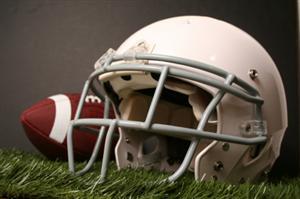| Complexity level: | 5 |
| Project cost ($): | 30 |
| Time required: | 5 hours preparation time, observation time only takes a matter of seconds. However, do allocate some extra time in case of any mistakes. |
| Material availability: | Besides the helmets, all the other materials should be obtained from a school laboratory. |
| Safety concerns: | Be careful to keep clear of the falling weight. |
Hypothesis
The higher the air pressure in the padding of the helmet, the smaller the force of impact.
Overview
Air pressure
Air pressure is the output force exerted on a column of air in a specific location. Air pressure in a container can be modified in 2 ways. The first way is by increasing the amount of air which increases the density of air in the container. The other way is by increasing the temperature which results in air molecules having more kinetic energy which in turn make them move faster and collide with increased frequency.
How is air pressure measured?
A barometer is used to measure air pressure. There are two most commonly used barometers, which are the mercury barometer and aneroid barometer.
The mercury barometer’s major feature is the glass tube filled with mercury. The tip of the tube is a vacuum. When air pressure increases, the mercury level increases and vice versa in low air pressure.
The aneroid barometer has a slightly different structure; it uses an aneroid or sylphon cell to measure air pressure. The aneroid cell is basically a metal chamber that contracts and expands under different air pressures.
Force of Impact
An impact occurs when 2 or more bodies collide, causing an intense shock for a short period of time. The intensity of this impact depends on the amount of force applied, the length of impact time and the speeds of the colliding objects.
With high speeds and a high amount of force, there would be deformation of the object being struck at the point of impact. Much like punching a sponge, the object being struck (the sponge) would deform when you punch it. However, if the object being struck was more brittle in nature, it would fracture. When 2 speeding vehicles crash into each other, metal is bent and twisted, as a result of the force of impact.
Scientific Terms
Materials
The materials required for this interesting science project are:
- 4 plastic football helmets
- Pump (bicycle or ball pump)
- Pulley
- A simulation of a human’s head (Styrofoam/Wood)
- 2 lengths of String of about 5 meters each
- Cellophane tape
- Accelerator Probe
- Computer (Intel processor of Pentium Dual Core or above)
Procedure
1. For this experiment, the independent variable is the amount of air pressure in the padding of the helmet. The dependent variable is the force of impact. The constants include the type of helmet used, the size of the dummy’s head and the probe being used.
2. Tie the string to the bottom of the pulley.
3. Look for something steady which has a hole in it to allow the string to be passed through, e.g. a metal hook on a brick wall. The structure must be at least 3.5 meters high. Pull the string so that the pulley is positioned at least 3 meters above the ground. Secure the pulley in position
4. Tie a weight to another string.
5. Attach this string through the pulley so that the weight can be easily raised or lowered.
6. Set up the equipments used to measure the force of impact. Do this by attaching the accelerometer probe to the computer. (When you purchase the probe, a cable and a CD for installation should come a long with it)
7. Carefully insert the accelerometer probe into the simulation of a human head by making a hole on the top of it and stuff the probe into it.
8. Use the ball pump with a sports needle attached to it. Pump air into the padding of the football helmet. It should read 0 mmHg on the probe. This shows that the probe’s basal reading has 0 impact and any change in this number would be due to the force of impact.
9. Put the simulation of the human head into the helmet. Make sure the structure is positioned upright and fasten it with cellophane tape to a flat surface to make sure it maintains its position throughout the whole experiment.
10. Release the weight on the helmet and the simulated head.
11. Record the reading of the probe. It should be captured in the computer.
Results
| Air pressure (mmHg) | Force of impact (N) |
| 10 | 50 |
| 20 | 40 |
| 30 | 30 |
| 40 | 20 |
| 50 | 10 |
For 10 mmHg, the force of impact is 50 N.
For 20 mmHg, the force of impact is 40 N.
For 30 mmHg, the force of impact is 30 N.
For 40 mmHg, the force of impact is 20 N.
For 50 mmHg, the force of impact is 10 N.
Conclusion
The hypothesis is accepted because as the air pressure in the padding of the helmet increases, the force of impact decreases.
Also consider
What other material is suitable to be used as a simulation of the human head?
Should a barometer be used in this experiment?
What if different weights were used? How would the results differ?
References
http://www.ehow.com/how_5175645_measure-atmospheric-pressure.html

